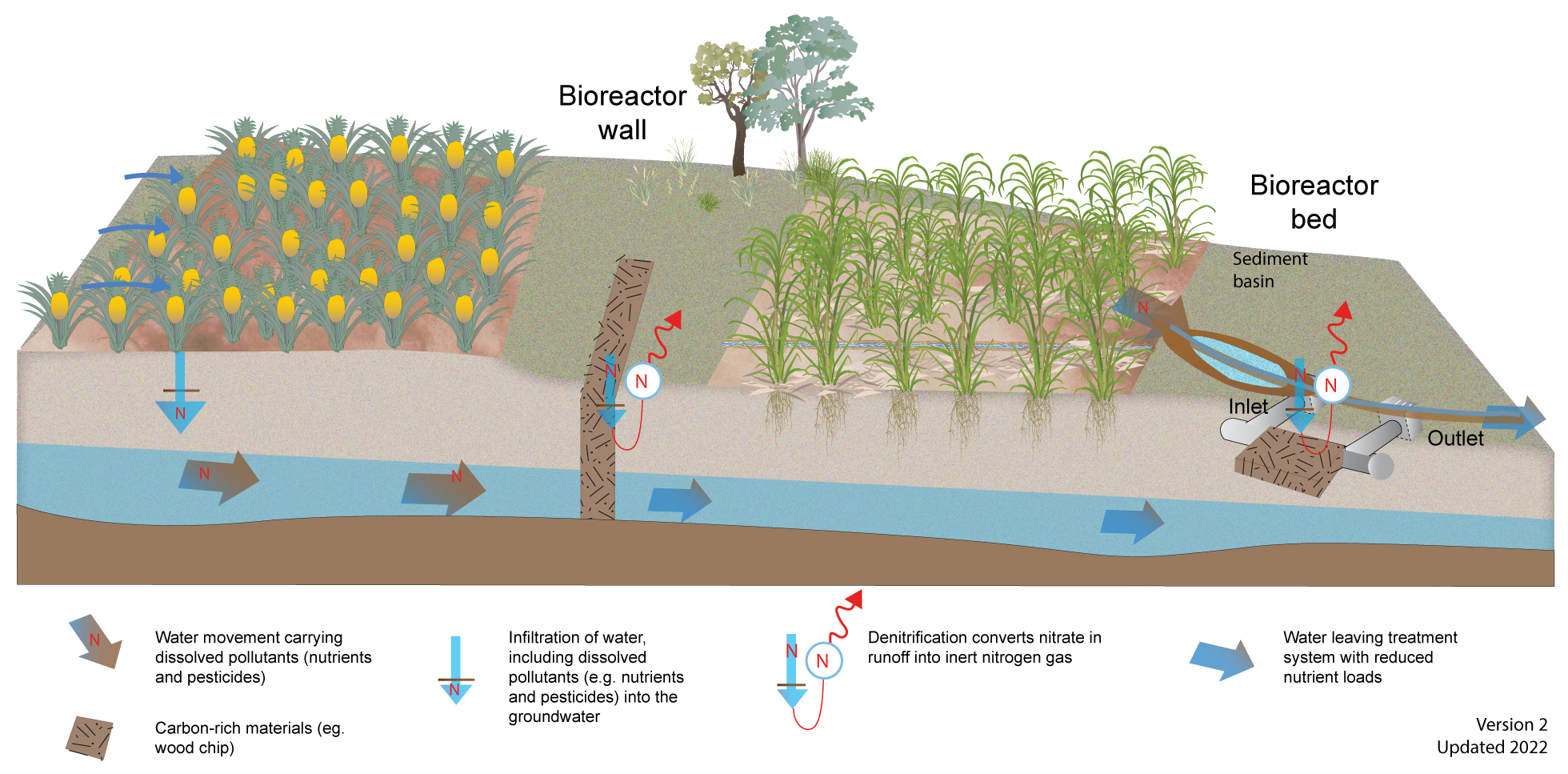|
|
BioreactorsBioreactorsSelect from the tabs below Other name/sWoodchip bioreactor, denitrifying bioreactor, denitrifying wall, bioreactor wall, denitrifying bed, bioreactor bed DescriptionDenitrifying bioreactors are systems filled with organic-matter (e.g. woodchip) designed to remove nitrate from shallow groundwater or surface water, through the process of denitrification. Bioreactors work by passing stormwater runoff, irrigation tailwater, wastewater or shallow groundwater containing nitrates through a carbon source (generally woodchips). As water fills and slowly passes through the woodchip, the dissolved oxygen levels decrease to create an anaerobic or anoxic environment suitable for the naturally-occurring denitrifying microbes to convert the nitrate into inert dinitrogen gas (N2), thereby permanently removing nitrogen from the water[6]. Under conditions with low dissolved oxygen levels, warm temperature, non-nitrate limited conditions and suitable pH (5.5-8.0), full denitrification to dinitrogen gas can occur[1][2][7][4]. Nitrate limitation in a bioreactor occurs when the nitrate is completely consumed and there is enough carbon to support additional denitrification, which can lead to undesirable by-products. There are two main types of bioreactors, bioreactor walls and bioreactor beds, suited to soils and hydrology of the site, specifically how nitrate is leaving the production area and where nitrate-rich water can be intercepted[7]. Bioreactor walls are used to treat shallow groundwater. They are designed to intercept and remove nitrate that has entered the soil profile and leached into the groundwater. They consist of a trench filled with woodchips, located perpendicular to the groundwater flow. Bioreactor beds consist of a bed of woodchips that receive and treat either surface water, via an open drain, or sub-surface drainage from pipes (e.g. tile drains, ag pipe) or wastewater (e.g. from aquaculture or protected cropping system)[8]. Water enters the bioreactor via an inlet structure and exits via an outlet structure, with excess flow bypassing the bioreactor. A sediment trap may be required upstream to prevent clogging of the woodchip[1][3][7]. There are three main types of bioreactor bed:
Effectiveness as a treatment systemDenitrifying bioreactors have proven effective at reducing nitrate in surface water and groundwater on sugarcane and horticulture farms in Queensland, with nitrate removal rates between 0.08 – 7.1 g N/m3/day[8][4]. The effectiveness of a bioreactor for removing nitrate and converting it to dinitrogen gas is strongly influenced by[8][4][5]:
A well-located and designed bioreactor, meeting these conditions, can remove nitrate at a cost of around $100 per kilogram of nitrate removed (based on an average nitrate removal rate of 3.4g N/m3/day in a 100m3 bioreactor bed receiving run-off for 250 days a year taking into account all planning, construction and maintenance costs over a 10 year lifespan[8]). The actual cost-effectiveness of a bioreactor will depend on the specific site conditions and project objectives and needs to be considered relative to other treatment systems or management intervention options. Refer to cost considerations for more information. Services and benefitsThe main service that bioreactors provide includes:
Case study: bioreactor bed on a cane farm near Ayr. DisclaimerIn addition to the standard disclaimer located at the bottom of the page, please note the content presented is based on published knowledge of treatment systems. Many of the treatment systems described have not been trialled in different regions or land uses in Queensland. The information will be updated as new trials are conducted and monitored. If you have any additional information on treatment systems or suggestions for additional technologies please contact us using the feedback link at the bottom of this page. References
Last updated: 24 May 2022 This page should be cited as: Department of Environment, Science and Innovation, Queensland (2022) Bioreactors, WetlandInfo website, accessed 18 March 2024. Available at: https://wetlandinfo.des.qld.gov.au/wetlands/management/treatment-systems/for-agriculture/treatment-sys-nav-page/bioreactors/ |

 — Department of Environment, Science and Innovation
— Department of Environment, Science and Innovation




